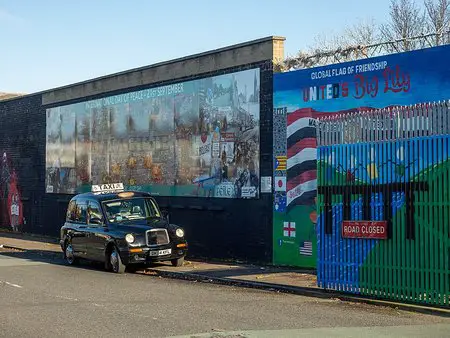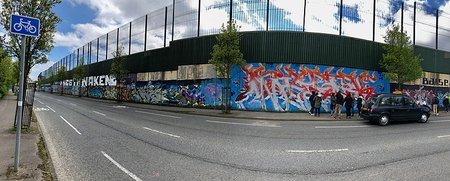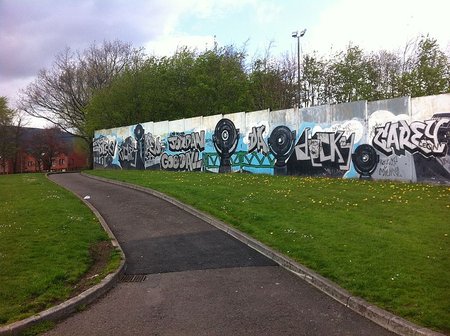About 50 Peace Walls and interface areas run through Belfast city which otherwise is a modern cosmopolitan place. Citizens of this city are still not over the fact that Nationalist and Unionist citizens entered into bitter war over the issue of North Ireland’s partition.

The Republic of Ireland became an independent state back in 1921 while North Ireland remained under British control. Naturally, this created a divisive atmosphere as some citizens wanted to reunite with Ireland and there were continuous activities of violence that stretched till the 1980s and was simplistically called ‘Troubles’. Protestant Republicans (Nationalists) and Catholic Loyalists (Unionists) divided themselves into polar groups.
The Troubles can be technically defined as the period between mid-1960 and Good Friday Agreement 1998 and though the violence centred in Belfast, the effects were felt in the Republic of Ireland and even England. The Peace Walls slowly became Belfast’s leading tourist attraction and is definitely a good place to stop at if you have an interest in the history of North Ireland. This particular brand of tourism is now called Conflict Tourism.
What are the Peace Walls?
Peace Walls are barriers against open attacks and warfare that almost razed the city to the ground some 40 years back during ‘Troubles’. Most of the walls are made of concrete and barbed wire and were erected by the Army and police to keep the groups from killing each other and to separate the polar Unionists and Republicans. These walls were interspersed with gates that only opened at specific times.
Some 2000 murals, hundreds of graffiti and lots of Wall art now deck these walls making it a photographers paradise. It’s interesting to note that many famous people including Dalai Lama and Bill Clinton have left their own messages of peace in the graffiti-covered barrier.
Neither the Troubles nor the Walls are limited to Belfast though the latter was definitely the epicentre of disruptive action and protests. There are walls in Portadown, Derry and other North Ireland towns. It’s estimated that if the walls are placed end to end they would stretch to more than 34 km.
What was the fight all about?
As any good guide will tell you the fight was also between the Catholics and Protestants. Protestants were mostly unionists or loyalists and thought of themselves as British and wanted to be a part of the UK. Catholics thought of themselves as Irish and wanted to leave the UK to join a united Ireland. Catholic families had lots of kids and led a lower standard of living than wealthier Protestants with fewer children.
Catholics were mostly discriminated against and had limited religious and voting rights. They had a difficult time getting houses and jobs and obviously, this Catholic/ nationalist sector had a lot of angst in them. The ‘Troubles’ were as much about civil rights as about politics!!
In 1972, a British Judge quoted from the Scarman Report stating that 179 homes were destroyed in August 1969 and some 1800 families left their homes (out of which 1500 were catholic).
When was the first Peace Wall built?
The first Peace Wall was built in 1969 when a violent series of Loyalist-Nationalist riots rocked the city. August 1969 was particularly traumatic when Conway Street was burnt. These were just locally constructed barricades that communities built themselves. When the British Army was deployed, they built barbed-wire barricades as temporary structures.
The Peace Walls were never meant to be permanent but as time passed their effectiveness was established and any ideas of tearing them down were dropped. In fact, the walls got longer and stronger with time and many more new walls sprung up. Not all these walls are from the era of troubles; many of them sprung up in 1994 when IRA declared a ceasefire.
The aesthetics of the Peace Walls changed gradually. The earlier versions were grey steel fences but they gradually became artistically toned brick walls with lovely shrubbery and trees. Some walls were coloured and they became an important part of the urban landscape. Peace finally returned to North Ireland after the Good Friday Agreement of 1998 was signed and Belfast became almost like any other prominent UK city.
Is there peace after the Peace Walls?
Apparently, there is peace in Belfast now though there are still strong traces of the tensions that led to the ‘Troubles’. Catholics and Protestants/ Republicans and Loyalists still don’t mix much with each other and there is ‘tolerance’ at best. Locals are accustomed to calling the 30-year-old period ‘Troubles’ and not the war because it helps them heal better but as a visitor don’t allow the word ‘Troubles’ to gloss you over. The death count during Troubles was more than 35,000 and half of these deaths were in Belfast. Approximately 50,000 people were injured.
Where to look for the Peace Walls?
Cupar Way
The Cupar Way that lies west of the city acts as a dividing line between the loyalist Shankill area and the Nationalist Falls Road. During the Time of Troubles there used to be a lot of sparring and fighting around here and the gate between the two neighbourhoods remained closed at all times. The conflicts at Falls road lasted for about 40 years and this is said to be the birthplace of IRA.

The famous International Peace wall here is 24 feet high and stretches for 800 meters; a prominent multi-level structure of concrete. There are gates that let thoroughfares pass through from both neighbourhoods but security measures are in place. At night most of the gates are closed.
The walls are covered in graffiti, art and murals and most tourists who come here write their own messages of peace on the wall and sign it. The Shankill Road is a working-class area and is one of the epicentres of Loyalism besides being the origin of UVF/ UFF.
Shankill Road
On the Unionist side (Shankill Road) you will notice more ‘Calls for Peace’ like ‘there is more in common than what divides us’. In retrospect, it’s easy to understand that peace calls are easier for the winning side. Look out for the relatively newly installed artwork on the Shankill side of Peace Wall… these are done over the earlier politically charged graffiti and inflammatory sectarian slogans.
There are hundreds of messages about change, unity and looking towards a peaceful new tomorrow. Try photographing some of these as these are transient artwork… soon a new set of messages will be painted over these by a new set of visitors. If you want you too can write your own message on the Peace wall.
Falls Road
The Nationalist side (Falls Road) is less forgiving with many depictions of political prisoners and ‘heroes’ who succumbed fighting for the independent identity of North Ireland. It’s not difficult to understand what the sentiments of people living on this side are. Surprisingly there are many more Palestinian flags and Spanish Basque flags here than Irish flags.
All the imagery that you will see is about stolen land, oppressed people and the idea of dispossession. The Arab Israeli conflicts, the Civil War of Spain and the Iraqi war of George Bush are themes that are explored and represented here via huge blocks of art.
It’s troubling to see that wire mesh protects the back of the houses that overlook the Peace Wall. There are metal frames running from the roof to the back fence and then to the ground… just like a cage. The portion of the wall on Fall road is called International Peace Wall and the peace messages by famous personalities are all here.
Murals to look out for
The Irish Window Mural on Falls Roadshows Ireland’s beautiful landscape passing through the fissures in North Ireland. Another wonderful mural on Falls Road (49) Sinn Fein headquarters shows Bobby Sands who was a member of the Provisional Irish Republican Army. Sands was jailed and succumbed in prison to a 66-day long hunger strike.
No visit of the Peace wall on Cupar way is complete without a tour of Bombay Street; this is a reconstructed street that was burnt down in the times of ‘Troubles’. Beautiful Troubles memorials to victims and famous ‘freedom fighters’ stand here.
After exploring the area around Cupar International Peace Wall you can go on a mural tour of West, North and East Belfast where most of the street art has a loyalist-Nationalist conflict theme
Other Peace Walls and Interface areas
In East Belfast Madrid Street there is a small Peace Wall that’s easy to overlook. A mural celebrating the contribution of women overlooks a garden and there are tall hedges behind. There is a small separate Peace wall separating the Catholic Short strand area from the protestant Newtownards road.
The Short Strand area of East Belfast, Duncairn Gardens and Manor Street (North Belfast) and Alliance Avenue also have Peace Walls. The local church here called St Matthew’s has a mobile peace fence showing the adaptability of these ‘walls’.
Does Westlink act as a Wall?
Roads can also be interface markers like Westlink road that divides Broadway and Roden Street. The Westlink road is the biggest access route to the south of the country (Republic of Ireland) and it was built in the 1980s cutting Roden street into two parts and dividing 2 working-class groups of opposing religious ethnic beliefs.
Catholic West Belfast is effectively separated from the protestant inner south Belfast and the rest of the city and during the time of ‘Trouble’ the many overhead bridges were used by the Army and police for access control.
Duncairn Gardens acts as a Wall?
To understand the concept of Peace Walls, visit the Duncairn Gardens that serve as a safe zone or a peace interface between protestant Ulster Loyalist Tigers Bay and Irish Republican New Lodge. The Catholic New Lodge area has many murals and most of them are along New Lodge Road.
This erstwhile epicentre of violence is now peaceful and has become a hub for pubs; you will find a great mix of live rock, Irish traditional music and techno here. The Duncairn Street (near the Duncairn gardens) was amongst the hardest-hit areas during the bombings of the Troubles. Locals used to call the area from New Lodge to Newington as ‘Murder mile’ because of the random killing of locals by loyalists. You will see a lot of politically furious graffiti in this area.
Does Alexandra Park have a Wall?
Alexandra Park in North Belfast is the only West European Park to be divided with a 3-meter wall and gate. The barrier or ‘Peace Wall’ was erected in 1994 marking the day of the IRA ceasefire. You can access the north area of the park from Antrim road (republican zone) and the south end of the park can be accessed from Shore road (loyalist zone).

The gate inside the wall only opens from 9 a.m. to 3 p.m. on weekdays. It’s ironic to see two sets of children’s playgrounds in the park; a Protestant set and a Catholic set. 200,000 pounds has been spent on the Alexandra Park refurbishment project.
Out of the 50 peace walls in Belfast, many have been physically demolished but the tension-filled interface areas flanked by markedly opposing cultural iconography on both sides is proof enough of their lingering mental effects.
Note:
The Black Cab drivers who show people around these places take good advantage of the concept of ‘conflict tourism’ and present a very negative and political image of the wall and the events preceding it. The tour of the Peace walls is intended to be only for mature minds. The taxi guides sometimes point out the rubble of houses that were attacked and such content might be disturbing.
Tours
It’s totally possible to visit the Peace Walls on your own but the experience is richer if there is a local guide around who will explain the history and stories behind all the murals and graffiti. Even if you are not a history buff, the Peace Walls have enough art on them to keep you interested.
There is a 2-hour black cab tour that will expose you to the politically skewed murals of Belfast and there is a guide who explains the backstories of those murals and the issues that happened during these 40 years of conflict. There are stops at Fall Road and Shankill road and an opportunity to write a message and sign the Peace Wall.
You can book this tour or one of several other Peace Wall tours from this Viator website.
What is the Future of the Peace Walls?
Many youngsters in the new generation of Belfast who grew up after the 1998 Good Friday Agreement see the Walls as a painful reminder of their past and are not too fond of it. In fact, many cross-community youth programs in Belfast have called for the walls to be torn down. Citing that the walls are proof of North Ireland’s strife-ridden past and keeping them will mean that the city is unable to move forward.
Many compare the Berlin Wall to North Ireland’s Peace Walls but it is unlikely that the latter will be taken down with a bang like the former. The process of erosion of the NI walls is more of a gradual process. Older citizens who still retain memories of ‘the Troubles’ say that the walls help them feel safer.
In February 2016 an 8-foot Peace Wall which had divided communities in Ardoyne North Belfast for more than 3 decades was demolished.
In the last 25 years, many billions of pounds have been spent on Peace programs in North Ireland. Peace IV programs focus on harmonising children and young people of both communities so that past bigotry is forgotten. Children visit each other’s schools and play together and these peace initiatives represent the only way these opposing sides communicate with each other as social interaction between Loyalists and Unionists is still non-existent or perfunctory at the best!!
Visiting Belfast always brands memories with the thought that how a civilised city of the UK still needs walls to ‘keep the peace’.
How to Reach the Peace Walls?
The Peace Walls are also called Peace Lines and many of them are away from the City Centre. In case you want to see the Peace Walls at multiple locations then the best way to reach is to ask a black cab driver to take you.
The city sightseeing bus will also stop at the Peace wall near Shankill Road and Fall Road. This particular Peace Wall can be reached from Belfast City Centre via a half an hour walk. You can walk in a loop around the wall and see murals on both sides and the neighbourhood cultural vibes.
If you are truly interested in North Ireland’s history and the Troubles then taking a trip to Derry and Portadown will be useful. You can also visit the Crumlin Gaol in Belfast to get more insight into political prisoners of this period. If the Murals here have impressed you then head off to Cathedral Quarter to do a street art tour.
 A travel addict. Still celebrating the day when he quit his high-profile corporate job to pursue his passion for travel writing.
A travel addict. Still celebrating the day when he quit his high-profile corporate job to pursue his passion for travel writing.